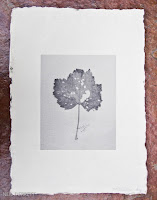As this was my first foray into salt printing the initial starting point is to obtain all the chemicals, and there are quite a few!! Its not just the chemicals, there are other specialist bits and pieces required, syringes, coating rods and specialist paper.

With any new photographic discipline knowledge is sort. This came by way of an excellent book by Christopher James 'The Book of Alternative Photographic Processes" pages 34 to 59.
The first part of the process is to size the paper that will be contact printed. Most bought water colour paper is already sized, however James always recommends a sizing stage of the process to ensure consistent results.
The sizing process consists of coating water colour paper, or any other paper that you are using for that matter, with a solution of gelatin and salt. To make 1 litre of sizing solution you will require 8g gelatin, 18g of sodium citrate, 20g of ammonium chloride and 1 litre of distilled water.
8g of photographic gelatin
Gelatin bloom
The first step is to soak the gelatin in 500ml of the distilled water. This takes approx 15 to 20 minutes. This is known as the bloom stage. Add the remaining water and heat to 100 f. When the mixture reaches the required temperature mix in the other chemicals.
Prepare a double boiler bath - a smaller tray that fits into a larger tray. This is to maintain temperature while the paper soaks in the sizing solution. Gelatin will revert to a hardened state if allowed to cool. Feed the paper in one sheet at a time allowing to soak for between 3 and 5 minutes.
Hang the paper in a dry dust free environment allowing to dry fully before using - approx 24 hours.


















































